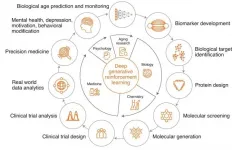(Press-News.org) Our genetic codes control not only which proteins our cells produce, but also - to a great extent - in what quantity. This ground-breaking discovery, applicable to all biological life, was recently made by systems biologists at Chalmers University of Technology, Sweden, using supercomputers and artificial intelligence. Their research, which could also shed new light on the mysteries of cancer, was recently published in the scientific journal Nature Communications.
DNA molecules contain instructions for cells for producing various proteins. This has been known since the middle of the last century when the double helix was identified as the information carrier of life.
But until now, the factor which determines what quantity of a certain protein will be produced has been unclear. Measurements have shown that a single cell can contain anything from a few molecules of a given protein, up to tens of thousands.
With this new research, our understanding of the mechanisms behind this process, known as gene expression, has taken a big step forward. The group of Chalmers scientists have shown that most of the information for quantity regulation is also embedded in the DNA code itself. They have demonstrated that this information can be read with the help of supercomputers and AI.
Comparable to an orchestral score
Assistant Professor Aleksej Zelezniak, of Chalmers' Department of Biology and Biological Engineering, leads the research group behind the discovery.
"You could compare this to an orchestral score. The notes describe which pitches the different instruments should play. But the notes alone do not say much about how the music will sound," he explains.
Information for the tempo and dynamics of the music are also required, for example. But instead of written instructions such as allegro or forte in connection with the notation, the language of genetics spreads this information over large areas of the DNA molecule. "Previously, we could read the notes, but not how the music should be played. Now we can do both," states Aleksej Zelezniak.
"Another comparison could be that now we have found the grammar rules for the genetic language, where perhaps before we only knew the vocabulary."
What then is this grammar, which determines the quantity of gene expression? According to Aleksej Zelezniak, it takes the form of reoccurring patterns and combinations of the four 'notes' of genetics - the molecular building blocks designated A, C, G and T. These patterns and combinations are known as 'motifs'.
The crucial factors are the relationships between these motifs - how often they repeat and at exactly which positions in the DNA code they appear.
"We discovered that this information is distributed over both the coding and non-coding parts of DNA - meaning, it is also present in the areas that used to be referred to as 'junk DNA'."
A discovery that applies to all biological life
Although there are other factors that also affect cells' gene expression, according to the Chalmers researchers' study, the information embedded in the genetic code accounts for about 80 per cent of the process.
The researchers tested the method in seven different model organisms - from yeast and bacteria to fruit flies, mice, and humans - and found that the mechanism is the same. The discovery they have made is universal, valid for all biological life.
According to Aleksej Zelezniak, the discovery would have not been possible without access to state-of-the-art supercomputers and AI. The research group conducted huge computer simulations both at Chalmers University of Technology and other facilities in Sweden.
"This tool allows us to look at thousands of positions at the same time, creating a kind of automated examination of DNA. This is essential for being able to identify patterns from such huge amounts of data."
Jan Zrimec, postdoctoral researcher in the Chalmers group and first author of the study, agrees, saying:
"With previous technologies, researchers had to tell the system which motifs in the DNA code to search for. But thanks to AI, the system can now learn on its own, identifying different motifs and motif combinations relevant to gene expression."
He adds that the discovery is also due to the fact they were examining a much larger part of DNA in a single sweep than had previously been done.
Fast value for the pharmaceutical industry
Aleksej Zelezniak believes that the discovery will generate great interest in the research world, and that the method could become an important tool in several research fields - genetics and evolutionary research, systems biology, medicine, and biotechnology.
The new knowledge could also make it possible to better understand how mutations can affect gene expression in the cell and therefore, eventually, how cancers arise and function. The applications which could most rapidly be significant for the wider public are in the pharmaceutical industry.
"It is conceivable that this method could help improve the genetic modification of the microorganisms already used today as 'biological factories' - leading to faster and cheaper development and production of new drugs," he speculates.
INFORMATION:
Read the article in Nature Communications:
Deep learning suggests that gene expression is encoded in all parts of a co-evolving interacting gene regulatory structure
https://www.nature.com/articles/s41467-020-19921-4
More about: mapping the motifs in DNA code
The researchers initially used DNA from yeast for their experiments. Self-learning algorithms, in the form of artificial neural networks, were trained to predict the relationship between DNA data and average amount of proteins in the cells.
For yeast, it was found that 82 per cent of the variation in gene expression could be predicted using DNA data alone.
When the same methodology was tested on six other organisms, including humans, the average association between DNA code and gene expression was measured at 60 per cent.
Further analyses of the expression of individual genes showed that what controls the level is the presence of certain motif combinations in the DNA code, which can be found in different parts of the DNA code - both in the coding and non-coding regions.
The research has been supported by NVIDIA Corporation, Swedish National Infrastructure for Computing (SNIC), SciLifeLab and the European Union's Horizon 2020 research and innovation programme.
Running a successful business has its challenges, but the COVID-19 pandemic has required many owners to pivot and look for new ways to operate profitably while keeping employees and consumers safe. Research from the Indiana University Kelley School of Business found that emotional intelligence - the ability to understand, use and manage emotions to relieve stress - may be more vital to a business' survival than previously thought.
"We found that entrepreneurs benefit much more from emotional competences than other competencies -- such as IQ -- due to high uncertainty and ambiguity that comes with the world of entrepreneurship and ...
MIT researchers have developed a type of neural network that learns on the job, not just during its training phase. These flexible algorithms, dubbed "liquid" networks, change their underlying equations to continuously adapt to new data inputs. The advance could aid decision making based on data streams that change over time, including those involved in medical diagnosis and autonomous driving.
"This is a way forward for the future of robot control, natural language processing, video processing -- any form of time series data processing," says Ramin Hasani, the study's lead author. "The potential is really significant."
The research will ...
Philadelphia, January 28, 2021 - A collaborative study from the Center for Injury Research and Prevention (CIRP) and the Center for Autism Research (CAR) at Children's Hospital of Philadelphia (CHOP) found that compared with their non-autistic peers, young autistic drivers have lower rates of moving violations and license suspensions, as well as similar to lower crash rates.
The findings were recently published online by the Journal of the American Academy of Child and Adolescent Psychiatry.
Obtaining a driver's license is an important milestone for adolescents and young adults. One-third of autistic individuals without intellectual disability obtain ...
WEST LAFAYETTE, Ind. - An improved extraction method involving chia seeds may provide new options for nutritional foods, medicine capsules and anti-aging products.
A Purdue University team has developed and patented the method to separate mucilage from chia seeds, yielding a protein-rich chia seed flour with improved bioactivity and functionality compared with conventional methods.
This work was supported by the USDA National Institute of Food and Agriculture, Hatch Act formula funds project 1019794.
Mucilage is a thick and gluey substance that surrounds chia seeds and can make processing the seeds for food or pharmaceutical uses much more difficult or nearly impossible.
"We are excited about our ...
King's College London researchers have found evidence that minocycline, a widely used antibiotic with anti-inflammatory properties, gave greater improvement in depressive symptoms in patients with treatment resistant depression with low-grade peripheral inflammation.
Improvement in depressive symptoms
In a four-week randomised clinical MINDEP (MINocycline in DEPression) trial, 39 patients with major depressive disorder were recruited from services linked to South London and Maudsley NHS Foundation Trust (SLaM) and via public advertisement.
The trial took place at the NIHR / Wellcome Trust King's Clinical Research Facility at King's College Hospital. The patients, who were taking their routine antidepressant treatment, were split into two ...
New research suggests that a higher dietary intake of long chain omega-3 fatty acids in childhood may reduce the risk of developing subsequent asthma, but only in children carrying a common gene variant. The study, led by Queen Mary University of London, is in collaboration with the University of Bristol and University of Southampton, UK, and Karolinska Institutet, Sweden.
In the UK, 1.1 million children (1 in 11) are currently receiving treatment for asthma and most adult asthma begins in childhood. The NHS spends around £1 billion a year treating and caring for people with asthma.
Senior author, Professor Seif Shaheen from Queen Mary ...
Helping people to self isolate after testing positive for covid-19 must now be a top priority for the UK government, argue experts in The BMJ today.
Dr Muge Cevik at the University of St Andrews and colleagues say the focus should be on those working in high exposure occupations, living in overcrowded housing, or without a home, and should include free and safe accommodation alongside adequate income support, job protection, and help with caring responsibilities.
Most countries have used testing as a tool to interrupt transmission chains by encouraging ...
Access to legal cannabis stores is associated with a reduction in opioid related deaths in the United States, particularly those linked to synthetic opioids such as fentanyl, finds a study published by The BMJ today.
Opioids are 'morphine-type' drugs that relieve short-term (acute) pain and pain at the end of life. There is little evidence that they are helpful for long-term (chronic) pain, but they are often prescribed for this reason.
This has led to widespread misuse and a sharp rise in overdose deaths, particularly in the United States. In 2018, there were more than 46,000 fentanyl related deaths, representing over two thirds of all US opioid related deaths that ...
A new study has shown that, while there is limited evidence for overall increased mortality in patients with atopic eczema, those with severe atopic eczema may have a greater risk of dying from several health issues compared with those without eczema, according to a new study in the Journal of Allergy and Clinical Immunology.
The research team, led by the London School of Hygiene & Tropical Medicine (LSHTM) and funded by the Wellcome Trust, compared the risk of dying in over 500,000 adults with atopic eczema with more than 2.5 million without eczema. Patients with severe atopic eczema had a 62% higher risk of dying compared to ...
27th of January, Wednesday, Hong Kong - Deep Longevity, a fully-owned subsidiary of Regent Pacific (HKEX: 0575), specializing in the development and the application of next-generation artificial intelligence (AI) for aging and longevity research, today announced the publication of an article in END ...


